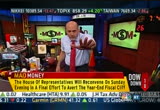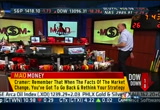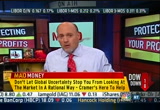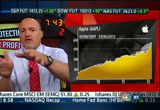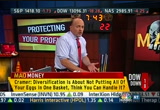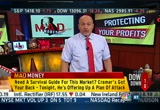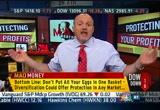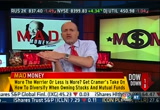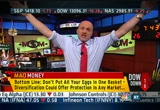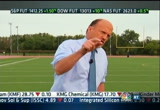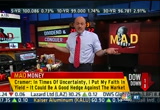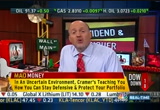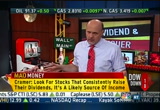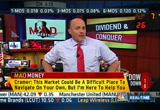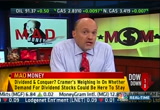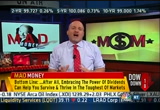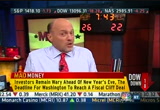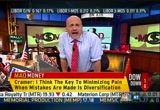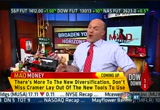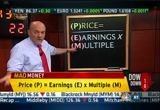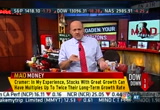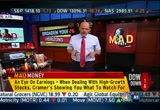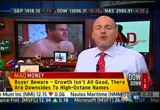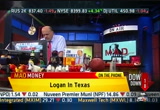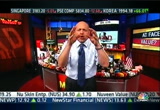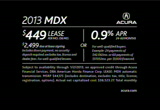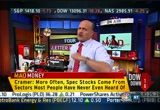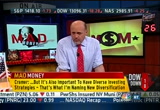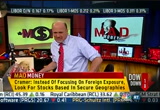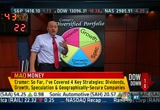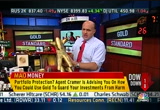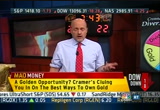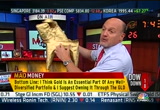tv Mad Money CNBC December 27, 2012 11:00pm-12:00am EST
11:00 pm
welcome to chevy's year-end event. so, the 5.3-liter v8 silverado can tow up to 9,600 pounds? 315 horsepower. what's that in reindeer-power? [ laughs ] [ pencil scratches ] [ male announcer ] chevy's giving more. get the best offer of the year -- 0% apr financing for 60 months plus $1,000 holiday bonus cash. plus trade up for an additional $1,000 trade-in allowance. hurry. bonus cash ends january 2nd. i'm jim cramer, and welcome to my world. >> you need to get in the game! >> firms are going to go out of business and he's nuts. they are nuts. they know nothing. >> i always like to say there's
11:01 pm
a bull market somewhere. >> "mad money," you can't afford to miss it. >> hey, i'm cramer. welcome to "mad money." welcome to cramerica. other people want to make friends, i just want to save you money. call me at 1-800-743-cnbc. in the face of crushing declines and uproarious rallies and even sometimes plain jane garden variety days in this market, there's a "mad money" toolbox to help you through and to help you become a better and wealthier investor. tonight i'm cracking it open, so listen up! if you're going to manage your own money, you have to recognize the value of maybe one of the most important issues out there, the value of humility, so, please, repeat after me, sometimes, i'm going to be wrong. come on, say it. sometimes, i'm going to be surprised, and one more. sometimes my stock picks just won't work out. look, i of all people understand
11:02 pm
that humility doesn't come naturally to everyone, but staying humble is important. why? other than greed nothing has cost more people more money than arrogance. if you own stocks, you have to accept the fact that you're going to be wrong perhaps even often. as the past three years have taught you painfully -- >> the house of pain. >> -- your portfolio will get hit with things you never saw coming, things you never imagined, things you never thought were possible. or put another way the one thing you can be sure of when putting a portfolio together is that at some point something is going to go wrong, and it will hit you totally out of left field. or even worse, something bad will happen that could easily have been anticipated and unless you took the appropriate precautions you'll end up being run over by a train that you actually saw coming. >> all aboard. >> think about how often have we been clobbered by the mess in europe. every time things start to look less horrible across the atlantic, every time we begin to
11:03 pm
wonder it maybe, just maybe, the worst is finally past, there's some hideous headline out of greece or portugal or spain or italy that the comes back with a vengeance and the s&p gets bashed down by a torrent of selling. that's why it's so important to prepare yourself and your stocks for the next catastrophe around the corner. expected or unexpected, so that you can make money in any market, or at least lose less and not just when things are going smoothly. you have to build this stuff into what i call your world view. you have to assume that somewhere, sometime, something will go wrong. i'm not saying you should be a super skeptic perma-bear, not at all. over the course of my 31-plus years in this business i've seen the averages climb way too way, watched the market make people way too much money to ever be that cynical and close-minded. being negative all the time has not historically been a lucrative strategy, and i don't see any reason why that should change now. there are a handful of
11:04 pm
incredibly smart, professional short sellers, hats off, able to turn pessimism into profits but i don't recommend trying to follow in their footsteps at home. i never recommend short selling on this show because it's inherently more risky than being long, which is authentic wall street gibberish for owning stocks. just a basic question of arithmetic. let's go through it. when you short a stock or bet against it, at best that stock goes to zero and you have a 100% gain. double at worst, it could never stop going higher. and you could lose 200, 300, 1,000%, theoretically lose an infinite amount of money. when you own a stock the situation is reversed. the most you can lose is 100% of your money. you can rack up much larger gains. we've seen ten baggers around here. ask anyone who bought apple near the generational bottom back in 2009. when it pulled back to less than 100 bucks, if they held on for the next three years, they snagged a 580% return. ♪ hallelujah >> i'm not telling you to be so
11:05 pm
afraid of what could go wrong that you'll pass up on that kind of massive gain. even if you're incredibly bullish, it would be silly to not make sure your portfolio is prepared for the next market-crushing disaster. come on. how many times has europe given and taken away? we know these things happen. we shouldn't let them stop from trying to make money but we should certainly do what we did can to protect our investments in advance. how do you do that and get ready for a calamity when you don't even know what it's going to look like? how do you expect the unexpected as an investor? one word, one magic word. diversification. look, diversification, as boring as it might seem, jim, i can't make thousands of percent with diversification. the single most important concept in investing, key to avoiding enormous losses and making sure you can stay in the game, our ultimate goal. why i diversify every wednesday and talk about this concept ad nauseam and call it the only free lunch in the jim cramer gospel. why i push it so hard as
11:06 pm
essential to protecting your portfolio in getting back even. if your portfolio is properly diversified you can handle any setback. you can come back from any financial disaster, i mean that. now, normally when i talk about diversification i mean making sure all your stock eggs aren't in one sector basket like in 2001 and 2002 when so many people left the building because of technology stocks. i go over this again because i can never say it too many times. means that no one sector, one segment of the economy should ever account for more than 20% of your portfolio. if you own five stocks, only one of them can be a tech stock, one a health care stock, one a financial, only one can be an energy company and one an industrial and only one a food and beverage-maker. what if you're not sure? always err on the side of caution. if two stocks trade together, underlying companies succeed or fail based on the same factors, you're not diversified, oil driller and oil producer, people think they are different, both part of the same sector, software and hardware, look,
11:07 pm
both techs whether we like it or not, not doing this to be arbitrary or capricious or make it more difficult to pick stocks. when you get too concentrated in one area the moment something bad happens to one of the two big stocks in that area you want to throw yourself off the bridge because the loss will be enormous. imagine if you owned too many industrials when the economy started to slow due to the blow up in europe and fast-growing markets like china slammed on the brakes with higher interest rates, you got obliterated. how about if you owned too many banks right before the financial crisis hit? i know a lot of people who did, by the way, they had such good yields going into the dotcom bust, where the ruination occurred, something then soured an entire generation of people on investing. spread your money across stocks in related sectors so when something happens and makes one of them go down hard the rest remain relatively unscathed. sometimes you can go higher. your basic diversification is mandatory in cramerica. if you're prepared for anything, not enough to make sure your stocks don't overlap, you need a portfolio that works in all kinds of markets, so tonight i want to explain and refine what i like to call the new diversification, how to protect
11:08 pm
your wealth and ensure you own something that works in increasingly chaotic, difficult, unforgiving, nauseating miserable market where diversified by sector alone can not be enough. the new diversification is all about owning the rights kinds of stocks. there are five different areas you need covered for maximum protection and upside. you need gold, dividend-paying stock with a high yield, growth stock and something speculative, yes, i believe in that, and something from a healthy geography. cover all five bases and you'll have a portfolio that can win in any market which, is why i'm going to explain what makes all five areas so essential, teach you how to analyze stocks by yourself, and each one, so you can fill every position with the best possible names. here's the bottom line. a good investor knows to always expect the unexpected, meaning keeping your portfolio diversified with 20% of your holdings in any one sector and following the new diversification for maximum protection, gold, high yield,
11:09 pm
growth, speculative stock, geographically safe stock and stick with cramer and i'll show you how to pick the best plays. let's go to loretta to start the questions. loretta. >> caller: thanks so much for taking my call. regarding your suggestion of not investing more than 20% of your portfolio in any one sector, does this only apply to portfolios with individual stocks, or do you calculate in the stocks which are within your mutual fund as well? >> okay. that's a great question. we don't talk much about mutual funds on the show. look, if your mutual fund is diversified in itself then basically you can say, well, why do i even need to pick individual stocks? that's why we have the show called "mad money." a lot of people like to pick individual stocks. i'm not necessarily encouraging or discouraging, here's how you do it if you want to. keep the mutual funds aside. we're talking individual stocks. it's great to have a bedrock mutual fund. i have it in my 401(k), not allowed to own individual stocks, you can't relate the two. putting that off in a separate quadrant.
11:10 pm
tom in california, please, tom. >> caller: hi, jim. from sunny warm san diego, america's finest city. >> i like the dads. >> caller: i'm a financial adviser and longtime viewer who appreciates what you do to educate and motivate investors. >> thank you. >> caller: i'm wondering if you would share your objective criteria are for investors to use in determining best of breed. thank you. >> well, i've got to tell you, best of breed, start with record dividends and then i go to how a company has done and consistently in good and bad times, and, yes, for best of breed i actually look at the product itself. is the product something i want to use, a bank i want to go to? is it, to use the danny meyer phrase, a great restauranteur, is it the one that's most hospitable to shareholders? anyway, new diversification. it's important. it's what we're preaching tonight. make sure your portfolio is home to some gold, a high yielder, okay. you need a growth stock.
11:11 pm
you know what, a spec, and then you need geographically safe area for one of them. i'll teach you how to pick the best ones. i want you to be comfortable with your own portfolio. "mad money" will be right back. >> don't miss a second "mad money." follow @jimcramer on twitter. have a question, tweet cramer, #madtweets. send jim an e-mail or give us a call at 1-800-743-cnbc. miss something? head tdmoney.cnbc.com. sometimes what we suffer from
11:12 pm
is bigger than we think ... like the flu. with aches, fever and chills- the flu's a really big deal. so why treat it like it's a little cold? there's something that works differently than over-the-counter remedies. prescription tamiflu attacks the flu virus at its source. so don't wait. call your doctor right away. tamiflu is prescription medicine for treating the flu in adults and children one year and older whose flu symptoms started within the last two days. before taking tamiflu tell your doctor if you're pregnant, nursing. have serious health conditions, or take other medicines. if you develop an allergic reaction, a severe rash,
11:13 pm
or signs of unusual behavior, stop taking tamiflu and call your doctor immediately. children and adolescents in particular may be at an increased risk of seizures, confusion or abnormal behavior. the most common side effects are mild to moderate nausea and vomiting. the flu comes on fast, so ask your doctor about tamiflu. prescription for flu.
11:14 pm
>> never in history has there been more doubts about this market. >> what went wrong? >> feel like the odds are stacked against you and the game not worth playing? but i know together we can win. >> jim cramer leveling the playing field for all. >> i'm not walking away from this market, and you shouldn't either. >> huddle up, cramerica. >> "mad money" kicks off weeknights.
11:15 pm
tonight i'm teaching you a novel way to fill those five slots in your portfolio, the five types of stocks that represent the new diversification, not just by sector but also by style and strategy, so that if executed correctly, you'll always own something that works and holds your interest. keeping you in the game, even when it feels so excruciating that you don't want to continue playing. stop looking at your statement and that kind of thing. at the same time, making sure you have some positions which can go much higher when times are good. what's the most important category? there's no question, people, it's yield. you need to own a stock, at least one, possibly more, with a big high-yielding dividend, but unlike when we diversify by sector, owning multiple high-yielders can actually be a good thing. i wouldn't own five dividend stocks because you might be extremely vulnerable if competition ever spiked in a big way or if the tax rate on dividends went up dramatically and your whole portfolio could get hurt. if you own one stock with a really large yield and one or
11:16 pm
two of the other names also sport decent dividends once they get raised, that's not a bad thing. i know dividend-paying stocks may not be what most people consider sexy, but you know what? dividends make you money, and to me that's the definition of sex appeal. i've got a pretty warped social life. my perspective here might be a little skewed but the fact remains buying high yielders and reinvesting your dividends back into the stocks, one of the greatest and most reliable ways to make money out there, plain and simple. it allows your investment to compound over time. in other words, over time the money from your past dividends pays dividends. giving you what we call compounding returns. now there's a huge misconception out there about dividends. people think that high-yielders are only about safety or generating income in your retirement, but if you go back to january of 1926, 40% of the return, 40 from the s&p 500 has come from reinvested dividends, and if you look at the last decade, the percentage is even higher. that's how essential dividends are to capital appreciation. of course, they are an income street and that's wall street gibberish for growing your money.
11:17 pm
dividend stocks aren't merely a place to hide when the market gets rough though they represent a fabulous safe haven and not only for retirees who care about capital preservation. investing in high yielders is one of the smartest strategies for making money period and one of the safest since dividend stocks have a cushion which we call yield support that helps them hang in there when everything else is getting annihilated. as the share price falls, yield increases and it gets too attractive for most investors to ignore. that cushion is the reason why i like accidental high yielders, i even call them ahys, whenever you can find them. these are stocks that yield north of 4%, not because of dividend boost, but because their share price is falling so far, so fast, causing the yield to skyrocket. time and again we've seen stocks bottom at this crucial 4% level or at least slow down their selling. happened during the financial crisis providing the company
11:18 pm
could pay the dividend and we've seen it happen in big industrial stocks that have been hammered by european woes. once the yield hits 4%, as long as dividend is safe, meaning it's backed up by the cash flow, these stocks tend to stop going down or slow. they are often fabulous bargains longer term. i also like the stocks companies that have recently raised their dividend. as a dividend hike it's a clear signal management can send about the strength of their business. remember, a company that can raise the dividend is one that's a steady reliable growth. equally important it's a company that you can be pretty darn sure won't be cutting the dividend any time soon. even better are the outfits put through dividend increases for 20, 30, even 40 or more consecutive years. that's stability, and that's part of the best of breed. other than accidental high yields and dividend boosts, how do you analyze a high-yielding dividend stock? like learning to drive, think safety first. high yields are attractive but never reach for yield. a very high yield can be a signal that the dividend is
11:19 pm
unsustainable, hey, and it will have to be cut, which is why we have to put the stocks through a rigorous safety inspection. yeah, i'm throwing the red flag on too high dividends. the dividend is sound, maybe the company can raise it, but it seems endangered, you know what you've got to do. sell, sell, sell. stay away. consider the cautionary tales of two real household names, radioshack and supervalue. the first half of 2012 stocks had been pounded so hard that their yields were in the stratosphere, but there was nothing accidental about these high-yielders, and in each case the yield was a huge red flag like the one i threw and almost broke the camera, sending a signal the payout would be cut. radioshack and supervalue eliminated their dividends and the stocks down massively almost fell through the floor. the ceo told me a year before he cut it that the dividend was safe. what do you look for to tell if a dividend is secure? first, above and beyond everything else we look at the earnings per share. my rule of thumb, if a company has earnings greater than twice the dividend payout, we know it can sustain the dividend even when earnings shrink and in that case you're almost home free, can't ever be certain but the
11:20 pm
dividend seems secure. if not, go to step two. look at the cash flow, especially important when dealing with those companies that have a lot of machinery or other heavy capital investments, cable companies, which cause them to report high depreciation and amortization costs. high yielding telcos, verizon and at&t, as communications networks, they don't come cheaply. the depreciation and amortization costs don't come out of a company's actual cash but they do skew the earnings lower, which is why the cash flow can often give you a better idea about the health of the dividend. a lot of callers call say, listen, jim, why do you like at&t, doesn't cover the dividend? it's the cash flow, okay? finally you have to look at the balance sheet to make sure there isn't a lot of debt coming due in the near future that can often necessitate a dividend cut if the company doesn't have cash on hand. last but not least, you need to know how to collect, how to actually collect the dividend. forget all the jargon like declaration date, "x" date, the record date. no, on "mad money" we care about only one date with dividends. that's the must-own date. that's the last day you have to buy a stock in order to claim its next dividend payout.
11:21 pm
the must-own date is always the day before the "x" date and that's all you need to know. bottom line, want to embrace the new diversification on top of the old sector kind, be prepared for every kind of market out there, absolutely must own at least one high-yielder. dividends protect your stocks and they're also a terrific way to make money. what's not to like? let's go to mary in missouri, please. mary. >> caller: mr. cramer, i read in the "wall street journal" a very small article on the dividend bubble. i'd like to know what that is and how it might affect my utility's dividend income. >> so glad you've asked me this question because for two years most of the cognoscenti have been saying bidding up the dividend stocks is a mistake. it's all that's going to crash and all that's happened is the interest rates have gone lower, lower, lower and dividend rates more attractive. the dividend bubble isn't something that really exists. not that much interest in the stock market and versus the ten-year or 30-year i think you're fine. that's all we have to look at, a competitive situation.
11:22 pm
ron in texas. ron? >> caller: yes, sir. >> what's up? >> caller: so, how do you know when to get out of a stock? let's say you're doing well, it's got a dividend, but you're way up. how do you know? >> how do you know to get out? look, one of the things that we like to do, have to stay in touch with the fundamentals. we don't do buy and hold here. we do buy and homework. if you suddenly see a decline in cash flow, suddenly see a company has a change -- like if a cfo leaves, that matters, but in general we don't like to be greedy because bulls make money and bears make money and hogs get slaughtered. if you can take out enough money to be able to play with the house's money, that's when you're golden. your portfolio should be able to dividend, not to buy, but dividend and conquer. make sure you have at least one high-yielder. that helps when it comes to diversification. after the break we'll try to make you even more money. keep up with cramer all day long. follow @jimcramer on twitter and
11:25 pm
11:26 pm
misanthrope, stock sadist who delights in spreading despair and making people miserable and not trying to make you hate stocks even more than you do in the wake of the flash crash, facebook ipo, so many examples of insider trading it's hard to count. i'm trying to help you cope with your own fallibility as investor to make sure you're as prepared as possible to avoid losses caused by the slings and arrows of an outrageous market or whips and scorns of a european politician. while also putting yourself in a position to maximize your profits when things are going well. yes, and you know we've got to do that because bulls make money and bears make money and hogs gets slaughtered. a diversified portfolio trumps conviction. used to have it on my pc. by never having all your stock eggs in one sector basket you'll never have to suffer through the agony of watching everything you own getting crushed when that basket gets run over by a truck or an oncoming train. what if you want to put an extra layer of protection against a market that's become
11:27 pm
increasingly volatile and difficult to fathom in recent years? that's where the new diversification comes in, diversification by strategy. just like being diversified by sector immunizes your portfolio against massive across-the-board losses, being diversified by strategy helps no matter what market we're in you'll own something that's working. reserve one space in your portfolio for a high-yielding dividend stock. now a good old-fashioned growth name, especially a secular growth stock. on wall street secular has nothing to do with public versus parochial schools or establishment clause and first amendment, which you know i question. no, on wall street when a company has secular growth, it means that unlike cyclical smokestack growers you aren't hostage to the economy and when you get your hands on a strong secular grower, that stock can keep lifting higher and higher.
11:28 pm
a la jackie wilson, going on the new high, after new high for as long as growth lasts. think about apple or whole foods or amazon. some of the major biotech companies, amgen, gilead, celgene, growing like the big companies of old, back when big pharma was synonymous with growth and not high dividend. when we buy a stock we're paying for a company's expected future earnings per share. i'll repeat that, really important. expected future earnings, not past. a lot of people call me with the past and say that looks cheap, future earnings. it's the basic valuation algebra, share price, p, price, equals the earnings per share, e, times what's known as the multiple, m. price-to-earnings multiple. e times m equals p, tells you what investors are willing to fork over for a company's future earnings. this blew me away when i got to goldman sachs. we're solving for "m" and the
11:29 pm
most important determining and vital ingredient that has the greatest effect on the size of the valuation, the company's growth rate, that's why we pay so much attention. the growth rate is what matters more than anything else in cramerica after the balance sheet and diversification. we'll pay a bigger multiple for businesses with faster growth because the earnings will get larger and larger in the years ahead. as a general rule of thumb, when it comes to high octane secular growers, the stock can trade up to a multiple as high as two times, twice the long-term growth rate before it gets too expensive for the vast majority of growth-oriented money managers. earnings growing at a 20% clip, the stock could fly as high as 40 times earnings, 40 multiple and typically a growth stock won't trade down to a multiple of one times its growth rate unless there's something seriously wrong with the fundamentals or we're in a nasty market soured on growth. possibly higher interest rates coming, inflation, making the multiples of growth stocks shrink as the future becomes less attractive to the yields
11:30 pm
that people can get from cash or treasuries or just plain hard cash because of inflation. lower rates make growth stocks more attractive and cause their multiples to expand. even more important when you want a high-growth stock you need to be especially sensitive to which direction the earnings estimates are going and whether those estimates are increasing at a faster or slower pace. these stocks can soar to new high after new high but remain cheap as long as analysts who cover them are raising the earnings per share estimates quickly enough. when the estimates have momentum, that's right, when you see a raising number, raise the rates, a stock like apple can double over the course of 12 months and the multiple is lower than where it started because the earnings estimates increased even faster than the share price this kind of earnings momentum allows the stock to resist even the downward gravitational pull of an economy, secular growth, not cyclical. be very, very careful here because when you're playing momentum, you're playing with fire. for the truly high octane growth stocks out there, if the time comes when the estimates have to come down or it looks like the growth is decelerating, splat.
11:31 pm
it's like driving a fast car right into a retaining wall or a human, you got it. when one of these companies stumbles the stock can fall faster than you can imagine. geez, where does chipotle, dropping more than 100 points, losing a quarter of its value in a matter of days, when in july of 2012 it reported a disappointing quarter that suggested the company might be more vulnerable to economic weakness than we previously thought. we thought it was a secular grower. suddenly there was the question did it have cyclical weakness? chipotle had been riding up for years, massive gains still, but after a growth name loses its mojo, got to be cautious because the pain can last for years as the stock goes through a painful process of george costanza-like multiple shrinkage. yeah, years, as momentum-seeking investors gradually play less and less for progressively slower earnings growth, and so they -- all the growth managers get shaken out and the multiple sinks to levels where the
11:32 pm
value-oriented investors become interested, think maybe there's a takeover. when you see multiple compression don't hang on for the full ride down. just sell. you can catch it later, believe me. bottom line, to build a portfolio that can work in every kind of market, you need a fast grower, preferably a secular growth stock with room to run and, remember, dealing with growth, it's worth it to pay up for a company that is still accelerating because once the momentum stock starts to slow down the multiple can shrink for ages before it bottoms. logan in texas, logan. >> caller: hey, jim, want to give you a big university of tulsa, oklahoma boo-yah. >> i'm loving that boo-yah. what's on your mind? >> caller: a couple weeks ago i was watching a similar show when you told us investors about a p.e.g. ratio and how to determine if a stock is expensive or not, and i was wondering what does it mean when a stock has a negative p.e.g. ratio? does that mean it's a company you want to avoid and what are other indicators to see if a stock has room to grow? >> you always have to worry. i like to switch to -- this is a
11:33 pm
complicated concept. i cover it in "getting back to even." times to go to cash flow, if it looks like there's no earnings, you say, well, what kind of earnings growth do i have if there's no earnings but if there's cash flow growth like the cable companies and telcos, it's not as valuable. i like the p.e.g. ratio for traditional earnings, not for ones that don't have earnings. frank in pennsylvania, please, frank. >> caller: jim, first and foremost, boo-yah. >> boo-yah right back. >> caller: a three part question for you, what does the term risk on, risk off mean, why is it so common and are these terms a signal to stay away from a stock? >> all right. i've been at it more than 30 years. this risk on, risk off is offensive to me, okay. it's offensive to me because i think it obfuscates what i need to be able to teach you. it's some hedge fund gibberish gobbledygook. who knows what's a risky stock, who knows what is not a risky stock? i know stocks, okay? here's what you need to know.
11:34 pm
it's not risk on, risk off. it's do i have cash or am i borrowing money to buy stocks? do i have cash, or am i buying high-growth stocks or value stocks? risk on, risk off, you'll never hear it used on this show ever because all it does is confuse you and tries to make me sound smart, but it tells you actually that i'm pretty darn stupid. risk on, risk off, not in cramerica. growing pains, not around here. you need to have a fast grower as part of your new diversified pattern. this is the way we're doing it. new diversification. it's worth it to pay up for a company that is still accelerating. if it decelerates, just go. stay with cramerica. taking control of your financial destiny is smart, but why would you go it alone? >> let me explain this to you. something that has a much larger bearing on you and the stock market as a whole. >> let cramer be your guide, your sounding board. >> i'm having a hard time with my favorite stock. >> i know you can beat these professionals.
11:38 pm
different kinds of stocks showing you how to put together a portfolio that's diversified by strategy. a toolbox with something that can work in any and every market no matter how tough or difficult! so far i've talked about dividends and growth. what else is essential for a truly balanced portfolio? how about something to keep you interested in focusing and opening your statement at the end of the month? in my view, you always want to own something, i know, going to sound heretical, something speculative. even if speculation has to be the dirtiest word in the business. except, of course, here in cramerica, where it's part of investing orthodoxy. not only is it okay for you to own these tempting risky broken-seeming stocks that trade in the single digits, i actually regard it as a necessity, as long as you follow my rules and speculate wisely. i don't fear criticism talking about this because it's made my investors a lot of money in my old hedge fund. i realize this is the exact opposite of everything you've ever been told by the usual purveyors of investing wisdom, gray beards telling you to focus
11:39 pm
on stocks and the big indices like the dow jones industrial average. blue chip didn't help you with the gm or the citigroup when they were annihilated or nearly annihilated during the financial crisis. there's a place for the dow stocks, many of which are high yielders, but there's also a place for speculation and index funds which is another thing the gray beards tell you to do. i'm not against those but i want you to pick some stocks, too, and i know you're going to do it so let's do it right. these so-called experts say stick with the index fund because the professionals who give you this advice presume that regular individual home gamers like you are brain dead, and that you're incapable of analyzing the prospects of publicly traded companies on your own. that's right. that's what they think of you. they don't think you can pick your own stocks. i'm not sure if they think you can pick your own nose. they assume you'll do less damage to your health if you stay away from tiny speculative stocks and sometimes they even
11:40 pm
tell you it's okay to own etfs as if they are not crazy enough sometimes. that is the smug conventional wisdom on wall street, and among the intelligentsia. look, i'm a grizzled veteran and i have been at the stock game for 30, geez, 32 years. i'm telling you it's totally bogus. these pros who dismiss speculation are completely ignoring what i call the human element, the emotional component of investing. the fact is a lot of people end up investing poorly because they aren't engaged. they find the whole process boring, and they don't stay on top of what they own. it is true if you neglect your own stocks, if you don't have the motivation to do the homework, then i don't want you in them either, and you won't do too well either because buying stocks without homework is no better than gambling, or you think frankly that you can roll the dice and, you know, somehow get lucky and that's not the way it's played. and that's where speculation comes in. you need something speculative in your portfolio as a tonic against boredom.
11:41 pm
high risk, high reward spec stocks are interesting an undeniable mystique to owning something that trades in the single digits. i can't fight it. they allow you to stay engaged and make it easier to keep your head in the game. always hear that speculation is the height of irresponsibility but i say a portfolio without speculation, without a long shot, so to speak, is a portfolio that won't capture your fancy, one that has you bored with your money and actually surrender it to people taking care of your fees. speculation doesn't just keep you interested. if you do it wisely with the right rules and discipline, i actually think you can generate enormous gains. truly massive returns almost unheard of in the stocks of larger more well-known and well-liked companies that are deemed safe. some of the biggest wins in my investing career came from speculation, but when done wrong swimming in under $10 waters can also lead to truly gut-wrenching losses, so i'm not saying this isn't dangerous. i'm saying i know you want to speculate so let's speculate wisely. how do you identify the winners and avoid the losers? two kinds of stocks that trade in single digit territory, hated broken stocks left for dead by
11:42 pm
the big institutional money managers and the relatively unknown stocks of undiscovered companies. in both cases you can get an enormous edge, the kind that's virtually impossible to have in the stocks of household names simply because so many of the big boys won't touch anything under five bucks. you're benefiting from what i call classic mispricing created by overpessimistic money managers, large institutions, big safe mutual funds, they don't want to own single-digit stocks, thinking they are too dangerous. they are afraid they will be questioned by their clients about why they own this junk. these money managers fear the downside of stocks that look broken, so when the fundamentals of one of these companies starts to turn, you can buy their stocks at terrific prices. since so many of the big boys won't go near them until they climb to higher levels. they want to sell low and buy high. i don't want you to do that. that's foolishness. that's what happened to ford. when ford was pushed to $4 and
11:43 pm
change, sally mae, speculative stock in 2009, got behind it at 6 and in two years it was at 16. more recently you cut one in sprint, traded down to nearly 2 bucks on fears the company was headed to bankruptcy even though the wireless business is lucrative and they were turning the corner. if you took a look at how sprint's bonds were trading and, well, if you hadn't looked at the common, just looked at the preferred, you might have gone into the common which doubled from its lows after spiking 20% on a single day on a much better than expected quarter. these stocks were supposed to be trash, dumpster juice, but if you went dumpster diving you caught doubles or triples. more often we speculate in stocks with tiny companies that most people never heard of. we're looking for sectors that seem like they can capture the imagination of the crowd. the next hot fad that will sweep through the wall street fashion show. sometimes, but not always, the fad will be backed up by genuine earnings power which is what we saw with all the little companies that make smartphone components in 2009, the first half of 2010.
11:44 pm
these speculative fads have the life cycle of a mayfly, so the trick is always first to remember to lock in your profits when you have them so you don't get burned when interest wanes and second, cut your losses before they come too large. when you speculate, you're not trying to find a stock that can buy and hold, right, we're not looking for buy and hold forever, not when you speculate. we want something that shoots higher and as long as you're disciplined and ring the register, it doesn't matter if that stock comes back down later. don't take that as a license to own the stock of a company with bad or deteriorating fundamentals. that's the essence of stupid speculation. you need to own something speculative. something that will help you stave off boredom and allow you to rack up huge gains, something to capture your fancy. a lot of fantastic stocks start as speculation. it could be a triple waiting to happen. stick with cramer.
11:45 pm
11:48 pm
all night i've been preaching and teaching, trying to show you how to build a portfolio of stocks that can work in virtually any and every type of market. from a nasty picnic, from the marauding bears. to euphoric pamplona-style running of the bulls. you always own something right for the moment by following what i call the new diversification. just like the old school diversification by sector that i push endlessly, this ensures your stocks won't all key off the same bad news and get beaten to bits at the same time. the new diversification by strategy, not sector, means that whatever the market is doing you'll always have at least one approach to investing that's paying off big time. now remember what we've gone over so far just in case you've missed it. you need a dividend-paying stock with a high yield, a growth stock and you need something
11:49 pm
speculative. what else? when i originally came up with the idea of new diversification, i said you should always have foreign exposure to portfolio, but given how the mess in europe crushed portfolios, what you really need is a stock that's in a safe geography. at times, when the united states is growing more slowly than the rest of the world, you need something international and not just a lot business overseas. talking about a company that's based in a foreign country and at other times when the rest of the world is falling apart and the u.s. looks pretty darn good by comparison, you need a stock that gives you domestic security, something that's entirely confined within our borders. because if those moments being exposed to the rest of the world is downright dangerous. what do i mean by domestic security? anything that's usa all the way. you can own a phone company like at&t or verizon. pick a regional to national
11:50 pm
restaurant chain like dunkin brands or a dollar store like dollar general. how about a real estate investment trust, federal realty or tanger factory outlets, you've seen those companies over and over. why? because they have been winners or just own the iyr. don't like etfs. but the point is in terms of international turmoil this slot shutting tipped by something all domestic and when the world is in much better shape, which is where we were after the financial crisis, then maybe you'll want to own a foreign company. bottom line. always own a stock that's from a safe geography. sometimes that means a foreign company. sometimes just got to always pay attention to the facts, pay attention. it means the domestic security is all american, and believe me. i think you're going to want to go domestic for the foreseeable future. "mad money" is back after the break. it's a brutal, full-contact sport. >> from the time the whistle blows. >> traders bracing for what
11:51 pm
could turn out to be a wild session. >> to the last play of the game. >> markets absolutely getting hammered today. >> i know it's not easy, but i promise to keep fighting for you. >> jim cramer, leveling the playing field for all. >> the road is a tough one, but the payoff can be your greatest win of all. >> join "mad money"'s training camp, weeknights.
11:54 pm
>> all night i've been talking to you about the new diversification, a way to diversify by strategy, not just sectors, so you can thrive in any market. look, we still believe in the old kind of diversification by group, but we've also got a new prism going here. remember, you need a high-yielder in your portfolio, a big dividend-paying stock for downside protection and the massive multi-year gains that come from reinvesting those dividends, and you must reinvest. second, you need a way to profit a whole lot when the market is in good shape. sometimes it is, and still potentially keep delivering gains if things get worse which is why you must have exposure to growth, preferably a high quality secular growth stock, where the earnings estimate is a powerful momentum. then a speculative stock, something that trades for less than $10, a company left for dead by big money managers on wall street or one they've never heard of. speculation keeps you doing the homework and keeps you from not opening your statement. i hate that, people put the statement in the drawer.
11:55 pm
fourth, you need something from a safe geography, either a foreign company if the united states is weak or a domestic security play if the rest of the world is stinking up the joint. and last but absolutely not least you need some gold, because gold has a special property, one that makes this metal precious to any diversified portfolio. gold tends to go up when everything else goes down. consider it your insurance against economic or geopolitical chaos. consider it insurance against uncertainty and inflation. all things that cause most stocks to decline, but also cause the price of gold to rise. i like to think of the gold position as a kind of stock insurance. would you own a home without homeowner's insurance? would you buy a car without car insurance first? you shouldn't invest without some gold exposure because gold pays off when everything else fails and also has been the best performing asset year after year for the last decade, racking up gains consistently over a period where at some point every other asset class has truly disappointed you.
11:56 pm
owning gold is not on the upside but can be minimal, about limiting the risk to the downside. at any moment there's a whole host of sectors that outperform gold but none look like the insurance policy like gold does. how should you own gold? the easiest and less risky way is through the etf or spider called gold shares but you've heard of it as symbol gld, right, which owns the metal and does a terrific job of tracking its price. you can also potentially call your broker and buy bouillon, the physical bars of gold as opposed to the cubes i like in my soup. this is for investors with a lot of money and can afford to buy gold in bulk. and pay to store it in a bank. got to tell you though, i like it, if you can do it. what about the gold miners? pick the right company, one with low cost that's growing production, they can outperform the commodity for a period of time, but remember it's not going to trade in lockstep with the commodity, and the same thing that makes gold valuable here, its scarcity, it's hard to get out of ground cheaply and there aren't a lot of cheap new mines also makes the gold miners
11:57 pm
perilous. gold miners can screw things up, debt, management teams, geography. virtually every time i've gotten behind a gold stock recent years i've been burned, shutdowns at their mines, higher than expected cash costs and delays and every time something goes wrong the stocks get hammered, so i gave up on the entire group and decided to stick with the gld or the physical commodity. here's the bottom line. if you want exposure to gold and not only want it, you need it, it's your portfolio insurance policy and everybody should have some. then you should just do the easy thing and own gold through the gld. not some gold miner that's only loosely connected to the underlying price of the commodity. that's too dangerous. this is gld. stay with cramer. ♪ a midas touch
113 Views
IN COLLECTIONS
CNBC Television Archive
Television Archive  Television Archive News Search Service
Television Archive News Search Service 
Uploaded by TV Archive on

 Live Music Archive
Live Music Archive Librivox Free Audio
Librivox Free Audio Metropolitan Museum
Metropolitan Museum Cleveland Museum of Art
Cleveland Museum of Art Internet Arcade
Internet Arcade Console Living Room
Console Living Room Books to Borrow
Books to Borrow Open Library
Open Library TV News
TV News Understanding 9/11
Understanding 9/11

